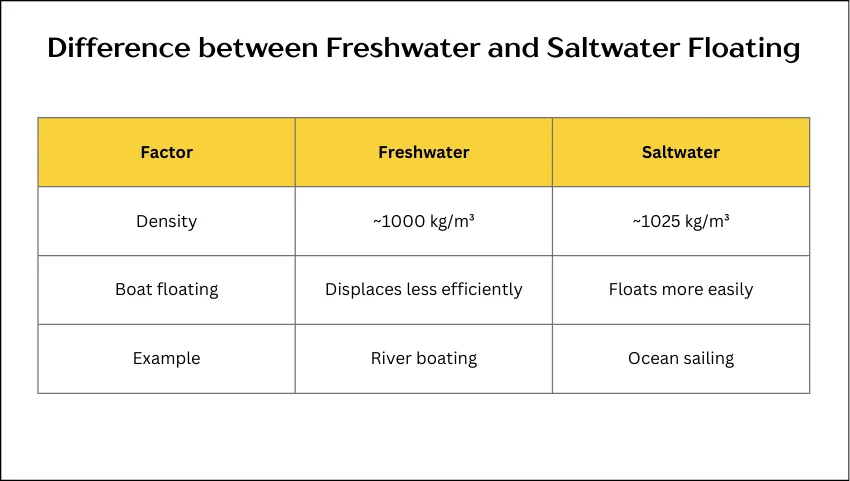⛵ Boat Floating Calculator
Calculate if your boat will float based on Archimedes' principle
ℹ️ How it works
This calculator uses Archimedes' principle: A boat floats when the buoyant force (weight of displaced water) equals or exceeds the boat's weight. The safety factor indicates stability - values above 1.2 are generally considered safe, while 1.0-1.2 is marginal, and below 1.0 means the boat will sink.
When you build or design a boat, one of the most important questions comes up: Will the boat float or sink? To answer this, you need a simple yet powerful tool called the Boat Floating Calculator. This calculator uses basic physics rules, especially Archimedes’ Principle, to figure out whether your boat design will stay afloat and how much weight it can carry safely.
What Is a Boat Floating Calculator?
A Boat Floating Calculator is an online or offline tool that helps you determine whether a boat will float in water. It is based on the principle of buoyancy, which states that an object submerged in a fluid experiences an upward force equal to the weight of the fluid it displaces.

In simple words:
- If the boat pushes away more water weight than the boat’s own weight, the boat floats.
- If the boat weighs more than the water it can displace, the boat sinks.
This calculator takes into account:
- Weight of the boat
- Load or passenger weight
- Shape and dimensions of the boat
- Density of water (freshwater or saltwater)
By entering these values, the calculator tells you how much of the boat will be underwater and whether it will float safely.
Importance of Boat Floating Calculator
The boat floating calculator is not just for engineers—it can help several groups of people:
- Students and Learners: Makes physics experiments easier to understand.
- Boat Designers: Ensure correct boat design before actual construction.
- Fishermen and Sailors: Helps to understand how much load their boat can carry.
- DIY Hobbyists: Useful for people building small rafts or canoes.
Without such calculators, testing boat floatation would mean building and testing again and again, wasting time and materials.
The Science Behind Boat Floating
To understand how the calculator works, you should first know the science:
Archimedes’ Principle
Discovered by Archimedes of Syracuse, the principle states:
“The upward buoyant force on an object immersed in a fluid is equal to the weight of the fluid that the object displaces.”
Key Points:
- Water pushes up on a boat with a force called buoyancy force.
- This buoyancy force depends on how much water the boat displaces.
- If buoyancy force ≥ boat weight, the boat floats.
- If buoyancy force < boat weight, the boat sinks.
Example
If a boat weighs 500 kg, it must displace 500 kg of water to float. If the boat shape displaces less than 500 kg of water volume, it will sink.
Formula Used in Boat Floating Calculator
The main formula used is Fb=ρ×g×V.
Where:
- FbF_bFb = Buoyant force (Newtons)
- ρ\rhoρ = Density of water (kg/m³)
- ggg = Acceleration due to gravity (9.81 m/s²)
- VVV = Volume of water displaced (m³)
To make the boat float: Fb≥W
Where:
- WWW = Total weight of boat + passengers + cargo
Factors Affecting Boat Floatation
Several factors must be considered while using the calculator:
1. Weight of the Boat
Heavier boats need to displace more water. Lightweight materials like fiberglass or aluminum make floating easier.
2. Boat Shape
A flat-bottom boat displaces water more efficiently compared to narrow boats.
3. Water Type
- Freshwater has a density of about 1000 kg/m³.
- Saltwater has a higher density (around 1025 kg/m³), which helps boats float more easily.
4. Balance and Stability
A boat may technically float but still capsize if not balanced properly.
How to Use a Boat Floating Calculator
Using the calculator is very simple. Just follow the steps:
- Input boat weight—Enter the empty boat’s weight.
- Add passenger/load weight—Add the total expected cargo or passenger weight.
- Enter boat dimensions or volume—provide length, width, and depth (if requested).
- Choose water type—select freshwater or saltwater.
- Click Calculate—the tool will show whether the boat floats and the percentage submerged.
Example Calculation
Suppose you have:
- Boat weight: 400 kg
- Passenger and cargo weight: 200 kg
- Total weight = 600 kg
Now, to float, the boat must displace 600 kg of water.
If boat volume underwater = 0.6 m³ and density of water = 1000 kg/m³:
Displaced water = 0.6 × 1000 = 600 kg
Since displaced water weight = total boat weight, the boat will float right at the waterline.
Real-Life Applications
- Shipbuilding Industry – Large ship companies use buoyancy principles while designing mega vessels.
- DIY Raft Builders—Helps check how many plastic barrels or wooden logs are needed.
- Physics Classrooms – Students learning about Archimedes’ principle use calculators to test problems.
- Safety Checks—Ensures recreational boats do not overload and capsize.
Advantages of Using a Boat Floating Calculator
- Saves time and material cost.
- Easy to use for both students and professionals.
- Provides quick estimation of load capacity.
- Prevents accidents due to wrong load calculation.
Limitations of Boat Floating Calculator
- Does not calculate stability in waves.
- Cannot fully simulate boat rocking or capsizing.
- Results depend on accurate input data.
That’s why, while this tool is helpful, real-world water testing is always important.
Difference between Freshwater and Saltwater Floating

| Factor | Freshwater | Saltwater |
|---|---|---|
| Density | ~1000 kg/m³ | ~1025 kg/m³ |
| Boat floating | Displaces less efficiently | Floats more easily |
| Example | River boating | Ocean sailing |
This difference is why ships sit lower in a river but higher when sailing in the ocean.
Educational Use
Teachers often use buoyancy calculators to explain:
- Why heavy steel ships float.
- Why icebergs float on water.
- Why wood floats while rocks sink.
DIY Projects with Boat Floating Calculator
If you are a hobbyist, you can use the calculator in
- Making paper boats.
- Building bamboo rafts.
- Testing plastic bottle boats.
It gives confidence before testing in real water.
Tips for Safe Boat Loading
- Always distribute the load evenly.
- Keep the boat weight below the maximum floating capacity.
- Use saltwater to your advantage if possible.
- Test in shallow water before deep water.
Frequently Asked Questions (FAQ)
Q1: Can a boat bigger than water float?
Yes. Even huge ships float because they displace water weight equal to their mass.
Q2: Why do boats sink sometimes?
Boats sink if they carry more load than they can displace or if water enters inside.
Q3: Does shape matter in floating?
Yes. Wide and hollow shapes displace more water compared to narrow and heavy shapes.
Q4: Do boats float better in seawater?
Yes, seawater’s higher density helps boats float more easily.
Q5: What formula is used in such calculators?
They use Archimedes’ principle: Fb=ρ×g×V.
Conclusion
The Boat Floating Calculator is an easy yet powerful tool that uses the principle of buoyancy to check whether your boat will float or sink. It is helpful for students, hobbyists, engineers, and shipping industries. By inputting a few values like boat weight, dimensions, and water type, you can quickly calculate floating capacity and avoid dangerous overload situations.
Whether you are building a small DIY raft or a large cargo vessel, remember the golden rule: the boat floats if it displaces a volume of water equal to or greater than its weight.
